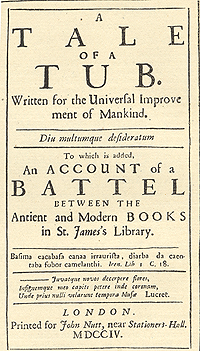
Back Cuento de una barrica Spanish قصه لاوک Persian Favola della botte Italian 桶物語 Japanese კასრის ამბავი Georgian A Tale of a Tub Dutch
 Cover, 1704. | |
| Author | Jonathan Swift |
|---|---|
| Original title | A Tale of a Tub |
| Language | Early Modern English |
| Genre | Prose and tragedy |
Publication date | 1704 |
| Publication place | Kingdom of England |
A Tale of a Tub was the first major work written by Jonathan Swift, composed between 1694 and 1697 and published in 1704. The Tale is a prose parody divided into sections of "digression" and a "tale" of three brothers, each representing one of the main branches of western Christianity from the 17th-century English perspective. A satire on the Roman Catholic and Anglican churches and English Dissenters, it was famously attacked for its profanity and irreligion, starting with William Wotton, who wrote that it made a game of "God and Religion, Truth and Moral Honesty, Learning and Industry" to show "at the bottom [the author's] contemptible Opinion of every Thing which is called Christianity."[1] The work continued to be regarded as an attack on religion well into the nineteenth century.[2][3] One commentator complained that Swift must be "a compulsive cruiser of Dunghils … Ditches, and Common-Shores with a great Affectation [sic] for every thing that is nasty. When he spies any Objects that another Person would avoid looking on, that he Embraces".[4]
The Tale was enormously popular, presenting both a satire of religious excess and a parody of contemporary writing in literature, politics, theology, Biblical exegesis, and medicine through its comically excessive front matter and series of digressions throughout. The overarching parody is of enthusiasm, pride, and credulity. At the time it was written, politics and religion were still closely linked in England, and the religious and political aspects of the satire can often hardly be separated. "The work made Swift notorious, and was widely misunderstood, especially by Queen Anne herself who mistook its purpose for profanity."[5] It "effectively disbarred its author from proper preferment" in the Church of England.[5]
- ^ Wotton, William. Observations on A Tale of a Tub (1705).
- ^ Clark, John R. "The Decorum of Madness". Form and Frenzy in Swift's Tale of a Tub. By Clark. New York City:Cornell UP, 1970.
But on the whole, the latter half of the eighteenth century and the first two-thirds of the nineteenth regarded A Tale of a Tub as a satire on religion and periodically vindicated religion against Swift's attack.
- ^ Montag, Warren (1994). The Unthinkable Swift: The Spontaneous Philosophy of a Church of England Man. Verso Books. p. 113. ISBN 978-1-85984-000-9. Quoting William Wotton:
one of the profanest banters upon the religion of Jesus Christ, as such, that ever yet appeared. ... is of so irreligious a nature, is so crude a Banter upon all that is esteemed as Sacred among all Sects and Religions among Men.
- ^ Horowitz, James (September 2020). "'Almost Normal', or, Everything You Always Wanted To Know About Swift But Were Afraid To Ask". Journal for Eighteenth-Century Studies. 43 (3): 281–291. doi:10.1111/1754-0208.12704. ISSN 1754-0194. S2CID 225457781.
- ^ a b Ousby, I. et al. (1993). The Cambridge guide to literature in English. Cambridge: Cambridge University Press.